Seurat as the Creator of Pointillism
As discussed on page 1 of Georges Seurat and the Golden Ratio in Art Composition, Seurat “is noted for his innovative use of drawing media and for devising the technique of painting known as pointillism.”
Seurat and the Golden Ratio
Seurat is also said by one art expert to have “attacked every canvas with the golden ratio.” Some have claimed this is nothing more than a myth to be debunked. I did my own investigation using PhiMatrix golden ratio design and analysis software, examining the 103 Seurat paintings shown at Wikimedia Commons. To avoid any claims that the results are biased or arbitrary, I based my golden ratio measurements solely on the height and width of the canvas. The paintings selected were based on the appearance of composition lines or elements that seemed to exhibit a conscious decision on the part of Seurat to apply the golden ratio. All golden ratio lines shown are calculated by the software and their placement on the painting is precise to within a pixel on the screen. I found golden ratios on this basis in about one third of Seurat’s paintings. Some may be subject to a little interpretation, but then some that were only close to golden ratios were excluded from the results as well. In addition, I found a number of golden ratios within the key features or elements of the painting themselves, and have included only two examples at the end of this article.
Explore, decide for yourself and learn
The results of this study are shown below. Click on any of the individual images below the slide show for a larger image with more detail and judge for yourself. The first group illustrates Seurat’s application of the golden ratio in horizons and focal points:
- Golden ratio at horizon, left shore and feet
- Note the position of the two trees and shaded area
This second group illustrates applications of the golden ratio in human form paintings and other subjects that are either more subtle or less precise. Click on any image to review in high resolution:
In other instances, Seurat may have used the golden ratio for composition of elements within a painting rather than basing the composition simply on its height and width. The example below illustrates apparent use of the golden ratio. The painting on the left shows golden ratios of the height and width, which reveal nothing. The painting on the right shows golden ratios that appear to have been used in the positioning of the men and the buildings in relation to the right side of the painting. Many other similar examples can be found in Seurat’s paintings where the artist’s intent seems clear, and not the result of simply searching for golden ratios afterwards.
If Seurat did “attack a canvas with the golden ratio,” we would expect to see golden ratios between elements within the composition and not just based on the simple height and width of the canvas. The painting below shows a number of rather clear and precise applications of the golden ratio. Measure them for yourself though and come to your own conclusions. Golden ratios can be found in:
- The sailboat is positioned in the golden ratio lines between the top and bottom of the painting
- The shoreline at the bottom is positioned at a golden ratio of the width of the painting
- The building on the shore is divided at a golden ratio point
- The height and width of the small sail are golden ratios of the height and width of the large sail
- The width of the small trunk of the tree is a golden ratio of the width of the large trunk of the tree
- The trees on the left horizon are positioned in a golden ratio spacing (it’s also a golden ratio if you use the center line of each tree rather than the highest point)
- The row boat and rower are positioned a a golden ratio point between the sailboat and the bottom of the painting
Click on the thumbnail below and then click on the View Full Size button to see the image in full resolution.
If you have any remaining doubt that Seurat used the golden ratio consider this: About one-quarter of his paintings had dimensions based on golden rectangles.
See more detailed analysis on Page 3

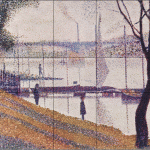







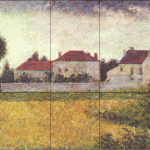


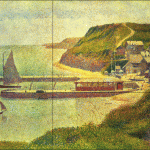
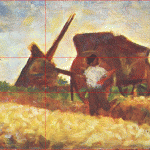


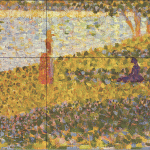
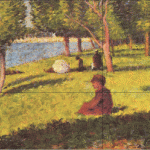

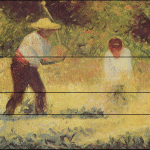


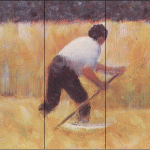






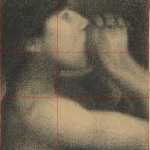

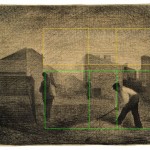
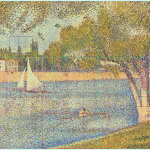


A set of numbers with a Phi common denominator actually does help in ordering a graphic composition. Thank you for the examples!
I did a few more Seurat examples that really stand out. He really was fond of placing his horizons on golden sections in his compositions. I find the debunking articles and even books by scholars (who invariably never present any evidence) absurd. Especially with so much evidence and experts who point out how it is just a fact.
https://www.behance.net/wip/1650462
https://www.behance.net/wip/1651980
Hi John. Thanks for your contributions to http://www.GoldenNumber.net and the PhiMatrix Facebook page. Your posting re Seurat’s “Le Jardinier” inspired me to review again all 103 paintings listed at https://commons.wikimedia.org/wiki/Georges_Seurat. There I found about 25 paintings whose proportions were very close to golden rectangles. I’ve added my review of these 25 paintings to page 3 of this article at https://www.goldennumber.net/georges-seurat-golden-ratio-in-art/3/, with a credit to you. I also listed on you the GoldenNumber.net Contributors page at https://www.goldennumber.net/contributors/. Keep those findings coming.
John, Gary, The Golden Rectangle has been a basis for my paintings for some time, I would appreciate a couple of minutes of your time to check out my site at http://carlo-fiorentini.sitelio.me
Hello Carlo. Thanks for sharing. Very nice work. I like the geometric designs with the shading and texture of a more realistic style.
Gary, Thank you for looking.